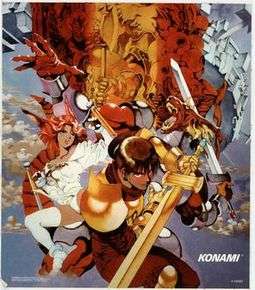Gaiapolis
Gaiapolis (Japanese: ガイアポリス 黄金鷹の剣, Hepburn: Gaiaporisu: Ōgon Taka no Tsurugi, lit. Gaiapolis: Sword of the Golden Hawk) is an overhead fantasy action RPG by Konami released for the arcades in 1993.[1]
| Gaiapolis | |
|---|---|
 Main promotional art by Akihiro Yamada. | |
| Developer(s) | Konami |
| Publisher(s) | Konami |
| Director(s) | Hiroyuki Ashida |
| Artist(s) | Shujiro Hamakawa |
| Composer(s) | Seiichi Fukami Satoko Miyawaki Yuji Takenouchi |
| Platform(s) | Arcade, NES |
| Release | May 1993 |
| Arcade system | Mystic Warriors-based hardware |
Plot
Prince Gerard Himerce seeks vengeance against the Zar Harc Empire for the destruction of his homeland, the Kingdom of Avalon. Joined by the half-human fairy Elaine Shee, last survivor of her clan, and Galahad, an exiled duke from the land of the dragons, the Prince goes on a journey to prevent King Darkness (formerly known as Albert Himerce, Gerard's older brother), the leader of Zar Harc, from reviving an ancient demon. Along the way, they are guided by a mysterious spirit known as the Warrior of Flame, who tells them to seek three keys that have been scattered around the world in order to enter the floating citadel of Gaiapolis.
Gameplay
Gaiapolis can be played by up to two players simultaneously. The objective of the game is to fight against every enemy in order to progress until defeating the boss at the end of each stage before time runs out. The player can choose to play as the Prince, the Fairy or the Dragon. The Prince and the Dragon are both swordsmen, while the Fairy is a martial artist who wields twin tonfas. Along the way the player can pick up items such as food to replenish health, weapon and equipment upgrades, eggs that carry guardian beasts inside, jewels with magic powers and treasures that give out more points. The game employs an experience point system in which the player's maximum health increases as he or she defeats enemies and increases levels. There are a total of 17 stages in the game, although some of the stages can be skipped depending on the course of action taken by the player.
The controls consist of an eight-way joystick for moving the character and three action buttons. The first action button serves as the primary attack button and performs consecutive attacks against enemies. The player can also hold the attack to guard himself against enemy attacks if his character is in possession of a shield (unless the player is controlling the Fairy, who uses her own tonfas to block enemy attacks). Rotating the joystick clockwise (or counterclockwise if the player is controlling Elaine) will cause the player character to perform a spinning attack. Pushing the joystick up, down, left or right twice will cause the player character to perform a running attack.
When accompanied by a guardian beast, the player can press the second action button to send the companion to attack nearby enemies or pick up items. However, the beast has his life gauge and will die if he takes too much damage. The player can press the button to call the beast back to his side and allow him to regenerate his own health. There are three guardians available: Goblin (a small armored warrior in a blue egg), Rollin (an armadillo-like creature in a brown egg) and Garuda (a flying baby dragon in a purple egg). Each beast has his own attack pattern. When the player picks an egg of the same color while his or her companion is still around, his companion's maximum health will increase. However, if the player picks a different colored egg, his companion will be replaced with one inside the egg.
A magic spell can be performed with the third action button if the player is in possession of a jewel. The more jewels in the player's possession, the more powerful the magic spell will become. However, the magic spell consumes all the jewels in the player's possession and his or her character will need to gather at least one more to perform another spell. There are seven magic spells in the game, with the most powerful one requiring ten jewels.
In addition to the standard continuation feature, the player can also use passwords to continue the game where they left off at a later point. The game over screen will give a nine letter password (six kana characters in the Japanese version), which the player can memorize and enter the next time the game is started. If entered correctly, the player will be taken to the last stage they played with the character they were using with their weapon, equipment and experience level intact.
NES version
Gaiapolis had also an only console porting for Nintendo Entertainment System, which was developed and published by the Taiwanese Thin Chen Enterprise, without a license from Nintendo (like all the games from that company) as well as Konami.
Related games
- Lightning Fighters - An overhead shoot-'em-up by Konami released excluisively for the arcades in 1990. Some of the magic attacks in Gaiapolis, such as the Lightning Sword and Dragon Laser, were originally from this game.
- Battle Tryst - A 3D competitive fighting game by Konami released exclusively for the arcades in 1998. Elaine appears as an unlockable playable fighter.
- Elaine from Gaiapolis makes a brief cameo in the interactive game TwinBee Paradise in Donburishima.
Reception
In Japan, Game Machine listed Gaiapolis on their June 1, 1993 issue as being the tenth most-successful table arcade unit of the year.[2]
References
- "Gaiapolis Operator's Manual" (PDF).
- "Game Machine's Best Hit Games 25 - テーブル型TVゲーム機 (Table Videos)". Game Machine (in Japanese). No. 450. Amusement Press, Inc. 1 June 1993. p. 25.